Shoulder Labrum Tears: Causes, Symptoms, Treatments, and Other Resources
The labrum plays a crucial role in stabilizing the shoulder joint, and tears can result from various factors, including trauma or overuse. This is a comprehensive guide on shoulder labrum tears, delving into the causes, symptoms, and treatments and offering additional resources to empower individuals dealing with this common shoulder injury.
Explore detailed insights into the anatomy of the shoulder labrum, recognize symptoms like pain and instability, and discover a range of treatment options from conservative approaches to surgical interventions. This article aims to provide a thorough understanding of shoulder labrum tears, enabling informed decisions and effective management strategies.
The Anatomy of the Shoulder
The shoulder is a complex and highly mobile joint that consists of several key anatomical structures:
Bones
- Humerus: The upper arm bone that fits into the shoulder socket
- Scapula or shoulder blade: Forms the socket of the shoulder joint (glenoid)
- Clavicle or collarbone: Connects the scapula to the breastbone (sternum)
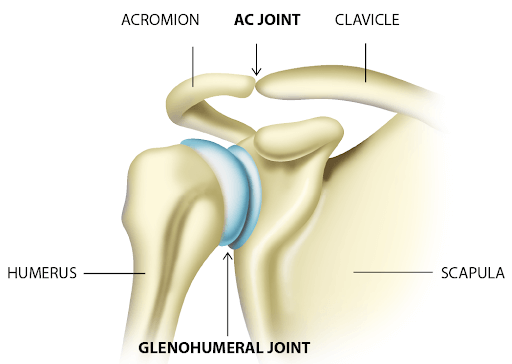
Joints
- Glenohumeral joint: The major ball and socket joint in the shoulder, where the humerus fits into the glenoid
- Acromioclavicular joint (AC): Formed where the clavicle meets the acromion (part of the scapula)
- Sternoclavicular joint (SC): Where the clavicle meets the sternum
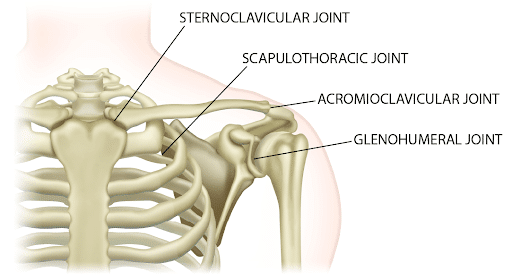
Muscles & Tendons
The rotator cuff muscles are a group of four muscles and their tendons that provide stability and movement to the shoulder. They include:
- Supraspinatus: The supraspinatus is located at the top of the shoulder and is crucial for lifting the arm away from the body.
- Infraspinatus: Positioned on the back of the shoulder blade, this muscle helps rotate the arm outward.
- Teres minor: A small muscle located below the infraspinatus that also assists in the outward rotation of the arm.
- Subscapularis: Found on the front of the shoulder blade, this muscle is responsible for rotating the arm inward and providing strength and stability to the shoulder.
Ligaments
Ligaments are thick pieces of connective tissue that connect bone to bone. The major ligaments in the shoulder are:
- Glenohumeral ligaments: Provide stability to the glenohumeral joint
- Coracoacromial ligament: Connects the coracoid process to the acromion
- Coracoclavicular ligament: Connects the clavicle to the coracoid process
- Acromioclavicular ligament: Provides stability to the AC joint
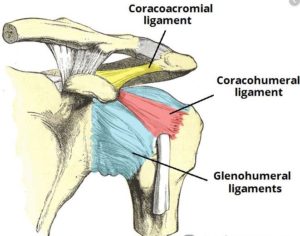
Labrum: The shoulder labrum plays a critical role in the overall function and stability of the shoulder joint. Below are the specific functions of the shoulder labrum:
Function of the Shoulder Labrum
The labrum is a cartilage ring situated within the socket of the shoulder joint. It effectively deepens the socket where the head of the humerus fits into the socket.
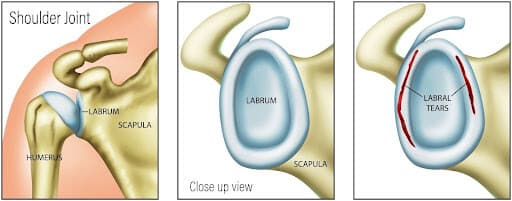
The main functions of the shoulder labrum include:
- Joint stability: The labrum contributes significantly to the stability of the shoulder joint by providing a deeper and more secure socket for the head of the upper arm bone (humerus). This stability is crucial for maintaining the integrity of the joint during various movements.
- Shock absorption: The labrum acts as a cushion, absorbing shock and distributing forces evenly across the joint. This helps prevent excessive wear and tear on the joint surfaces and reduces the risk of injuries.
- Range of motion: While providing stability, the labrum also allows for a wide range of motion in the shoulder. It facilitates smooth movement of the humerus within the glenoid socket during activities like reaching, lifting, and throwing.
- Muscle attachment: Various ligaments and tendons of the shoulder muscles attach to the labrum, enhancing the overall function of the shoulder complex. This connection between the labrum and surrounding structures contributes to coordinated and effective shoulder movements.
The Joints in the Shoulder
The shoulder comprises two major joints:
Glenohumeral Joint
The glenohumeral joint, often referred to as the shoulder joint, is a ball-and-socket joint formed by the head of the humerus (upper arm bone) and the glenoid cavity of the scapula (shoulder blade). The ball is the head of the humerus, whereas the socket is the glenoid. This joint allows for a wide range of motion, including abduction, adduction, flexion, extension, and rotation, making it one of the most mobile joints in the human body.
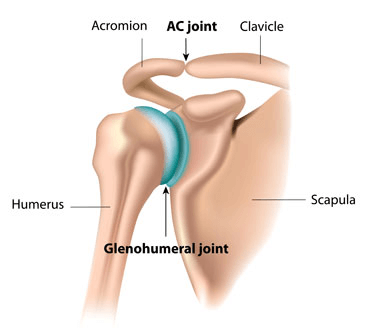
Acromioclavicular Joint
The acromioclavicular (AC) joint is formed when the acromion (a bony projection on the scapula) meets the clavicle (collarbone). This joint is responsible for allowing the shoulder to move up and down and to perform shrugging motions.
What Is a Torn Labrum in the Shoulder?
A torn labrum in the shoulder refers to a tear in the ring of cartilage (the labrum) that surrounds the shoulder blade’s glenoid cavity.
Labrum shoulder tears can be categorized based on their location relative to the middle of the glenoid socket (cavity).

Labrum tears are located either above (superior) or below (inferior) the middle of the glenoid socket. A tear above the middle of the socket is referred to as a SLAP (superior labrum, anterior to posterior) lesion.
Labrum tears below the middle of the glenoid socket are called Bankart tears or lesions. These tears are commonly associated with shoulder dislocations, where the head of the humerus is forced out of the socket, causing the labrum to detach from the glenoid. Bankart lesions lead to shoulder instability and a higher risk of recurrent dislocations.
Different Types of Shoulder Labral Tears
Labral tears in the shoulder can vary based on the location and cause of the injury. Below, we’ll look at some of the most common types, including Bankart and SLAP tears, to understand their specific characteristics and impact on shoulder function.
Bankart Tears
A Bankart tear refers to a specific type of injury to the shoulder joint, specifically the labrum. A Bankart tear typically involves a detachment of the labrum from the glenoid. The most common cause of a Bankart tear is a traumatic dislocation or instability of the shoulder joint, often occurring during sports, falls, or accidents.
When the shoulder dislocates, it can lead to the tearing or detachment of the labrum from its normal position.
Superior Labrum Anterior to Posterior (SLAP) Tears
SLAP tears are specific injuries that affect the labrum of the shoulder joint. A SLAP tear occurs at the top (superior) part of the labrum, where the biceps tendon attaches. These tears often result from repetitive overhead motions, such as those in throwing sports or heavy lifting, and can also occur from acute trauma, such as a fall on an outstretched arm.
What Does a Torn Shoulder Labrum Feel Like?
A torn shoulder labrum may cause persistent shoulder pain, a sensation of instability, and a limited range of motion. Individuals may experience a clicking or popping sound during certain movements, and activities like reaching overhead or lifting objects may exacerbate the discomfort.
Shoulder weakness and a feeling that the joint may “give way” are common sensations associated with a torn labrum. Typical symptoms occur in front of the shoulder or deep inside the joint.
Arm Pain at Night
Arm pain at night can be miserable. The pain can interrupt your sleep and erode your quality of life. Irritability becomes increasingly more common. What are the causes? When should I worry about it? What are the treatment options for arm pain at night? The neck is composed of 7 boney building blocks numbered 1- 7. Sandwiched between the bones is a disc that functions as an important shock absorber. The cervical discs are susceptible to injury due to trauma, degeneration, repetitive motion, and surgery. Common disc injuries include disc bulges, and herniations. The injured disc can compress or irritate one or more nerves resulting in arm pain at night. It can…
Read More About Arm Pain at NightLeft Shoulder Blade Pain
Learn to know the symptoms and causes of shoulder blade pain as well as the diagnostic tests to run for it and its treatment options. Shoulder blade pain can be a common, annoying, hard to diagnose problem. There are many different causes of shoulder blade pain and the exact cause of the shoulder blade pain will determine what type of treatments would be recommended.
Read More About Left Shoulder Blade PainMuscle Spasm In Shoulder
A muscle spasm, also known as a muscle cramp, is a sudden and involuntary contraction or tightening of a muscle or group of muscles. This can occur in any part of the body but is most commonly experienced in the legs, arms, and back. These spasms can last for a few seconds up to many minutes. Occasional muscle spasms may not be something to worry about, but chronic muscle spasms can be a serious issue. In the shoulder, there are many muscles that can go into spasm. These spasms or cramps can cause pain, stiffness, and limited mobility.
Read More About Muscle Spasm In ShoulderShoulder Pain When Reaching Across Body
Shoulder pain can make simple chores almost impossible. Have you ever reached for an object high on a shelf only to have pain that takes your breath away? What causes shoulder pain when reaching across the body? What is shoulder impingement? What does shoulder impingement feel like? Can a shoulder X-ray show shoulder impingement? What are the treatment options for shoulder pain when reaching across the body? ulder impingement and rotator cuff injuries are among the most common causes of shoulder pain (1). Both can cause shoulder pain when reaching across the body. Shoulder impingement is a painful condition in which the bursa and muscles of the shoulder are pinched or compressed.
Read More About Shoulder Pain When Reaching Across BodyShoulder Pain When Sleeping
There are several reasons why shoulder pain at night occurs or is aggravated; The common explanations include: Sleep typically involves a static position lasting hours at a time with little or no movement. Sleeping on your side places additional pressure on the tendons and bursa of the shoulder. Sleep can cause muscles and tendons to settle in a slightly different position resulting in additional pressure and reduced blood flow. Identifying the underlying problem is important! This allows therapy to focus exclusively on the exact problem or problems. When appropriate conservative care is always the first line of treatment. Focus is typically on strengthening and improving range of motion.
Read More About Shoulder Pain When SleepingCauses of Shoulder Labral Tears
Shoulder labral tears can result from various causes, including:
Repetitive Overhead Movements
Athletes engaged in sports like baseball, swimming, or weightlifting that involve repetitive overhead motions may develop labral tears over time due to the stress on the shoulder joint.
Dislocation
Dislocating the shoulder, where the upper arm bone (humerus) comes out of the shoulder socket, can lead to labral tears. The labrum may tear during the dislocation or due to the shoulder being relocated.
Degenerative Changes
Over time, the labrum can undergo degenerative changes, becoming more susceptible to tears. This is often seen in older individuals.
Trauma
Acute trauma often involves a fall on an outstretched arm or a direct blow to the shoulder, which can forcefully displace the humerus, leading to labral tears. This mechanism is commonly seen in contact sports or accidents.
Instability
The stability of the shoulder is dependent upon muscles and ligaments. Ligaments are thick pieces of connective tissue that connect bone to bone. When shoulder ligaments are stretched or injured, shoulder instability can ensue.
Shoulder instability is a common cause of shoulder labrum tears. Unfortunately, this is often ignored by surgeons and other healthcare professional.
How Is a Labral Tear Related to Shoulder Instability?
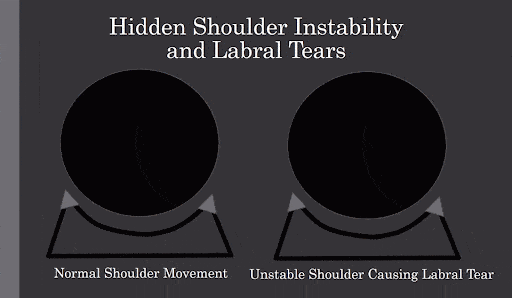
The animated GIF above compares normal shoulder movement with unstable shoulder movement. The left shows the ball in a shoulder socket that is stable. It moves a little, but it doesn’t bang into the labrum (lip of the socket, represented by the little triangles).
The image on the right shows what can happen when the ligaments are loose (hidden shoulder instability) and the ball moves too far out of the socket and crashes into the labrum. Ouch! While you would think you would know if your shoulder is unstable, it rarely works out that way.
When to Seek Professional Care
It’s important to seek medical attention if you experience the following symptoms and you suspect a labral tear in your shoulder:
- Persistent shoulder pain: Ongoing or persistent pain in the shoulder joint, especially during rest or specific movements, may indicate a labral tear. If the pain is severe and has not responded to conservative therapy, it’s essential to consult a healthcare professional.
- Shoulder instability: A feeling of instability or “giving way” in the shoulder joint, particularly if it occurs frequently, suggests a potential issue with the labrum. This feeling may be accompanied by a sensation that the shoulder is slipping out of place.
- Clicking or popping sensation: Audible clicks or pops during shoulder movements can be indicative of a labral tear. These sounds may occur as the torn labrum moves within the joint.
- Limited range of motion: Difficulty or pain when moving the shoulder, especially in certain directions, can be a sign of a labral tear. If you notice a reduced range of motion, it’s advisable to consult a healthcare professional.
- Weakness in the arm: Muscle weakness in the affected arm may result from a labral tear. This weakness can impact daily activities and may be noticeable during tasks that require lifting or reaching.
- Recurrent shoulder dislocations: If your shoulder dislocates or feels like it’s dislocating frequently, it could be due to a labral tear. Recurrent dislocations may require medical evaluation and intervention.
- Numbness or tingling: While less common, nerve compression or irritation associated with a labral tear may lead to numbness or tingling in the shoulder or down the arm.
How Labrum Tears Are Diagnosed
A combination of various diagnostic methods allows healthcare professionals to accurately assess the shoulder labrum’s condition. Physical examination provides initial insights, X-rays rule out bony abnormalities, MRI offers detailed soft tissue images, and diagnostic arthroscopy allows for direct visualization and potential treatment.
The choice of diagnostic tools depends on the specific circumstances and the severity of the suspected labral tear. The following are used to diagnose labrum tears:
- Physical examination: The doctor will evaluate your shoulder’s range of motion, looking for limitations, pain, or instability during various movements. Muscle strength in the shoulder and arm may be assessed to identify weaknesses or imbalances. The physician may gently feel the shoulder area to detect tenderness, swelling, or irregularities, which can be indicative of a labral tear. The two most common physical examination tests to identify shoulder labrum injury are the O’Brien Test and Speed’s Test:
O’Brien Test (Active Compression Test):
- Procedure: The patient stands with the shoulder flexed to 90 degrees and the elbow fully extended. The arm is then adducted 10-15 degrees across the body, and the thumb is pointed downward (internally rotated). The examiner applies a downward force to the arm while the patient resists. The test is repeated with the arm supinated (palm up).
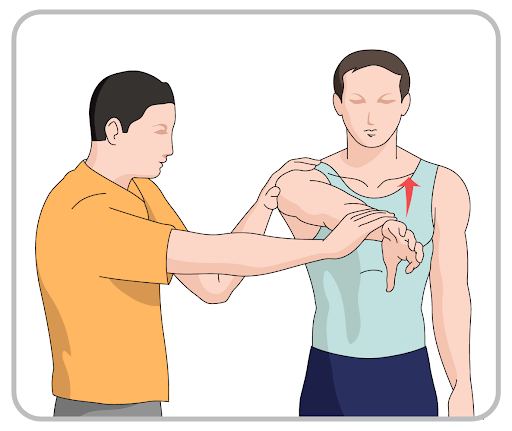
Speed’s Test
- Procedure: The patient stands with the elbow extended and the forearm supinated. The examiner applies resistance as the patient flexes the shoulder.
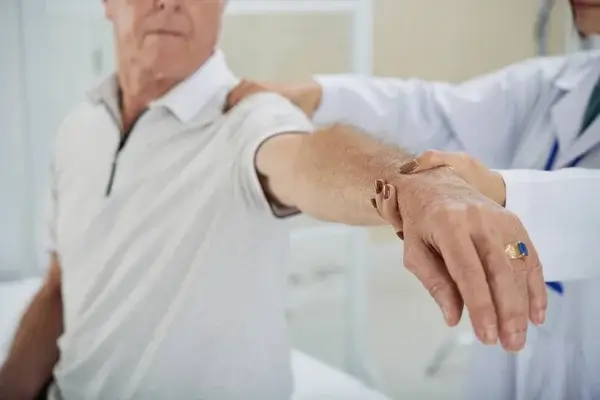
- X-rays: X-rays are useful for assessing the bones and joint structures of the shoulder. While they do not directly show soft tissues like the labrum, they can help rule out other conditions and identify potential bony abnormalities.
- MRI scan – soft tissue visualization: MRI is a highly effective imaging technique for visualizing soft tissues, including the labrum. It provides detailed images of the shoulder joint, helping to identify the presence, location, and extent of labral tears. In some cases, a contrast dye may be injected into the shoulder joint before the MRI (arthrogram) to enhance the visibility of the labrum and surrounding structures.
- Diagnostic arthroscopy – direct visualization: Arthroscopy is a surgical procedure used to diagnose and treat joint problems. It involves inserting a small camera (arthroscope) into the shoulder joint through a small incision. This allows the doctor to directly visualize the labrum and other structures, confirming the presence and extent of a tear.
Common Treatments for Shoulder Labrum Tears
Shoulder labrum tears can be effectively managed through a variety of treatment options, ranging from conservative measures to surgical interventions. The choice of treatment depends on factors such as the severity and type of labral tear, symptoms, and the patient’s overall health. Here’s an overview of some common treatment approaches:
Rest and Modification
Shoulder labrum tears may benefit from conservative measures such as rest and modification of activities. Resting the affected shoulder helps alleviate strain and allows the tear to heal. This approach is particularly suitable for individuals experiencing mild symptoms, such as occasional pain or discomfort.
It involves avoiding activities that exacerbate symptoms, modifying daily tasks, and implementing home remedies such as ice application and gentle stretching.
Physical Therapy
Treatment options initially include physical therapy, which is designed to restore range of motion and strength to the shoulder. Physical therapy plays a crucial role in the comprehensive management of shoulder labrum tears.
A customized rehabilitation program focuses on strengthening the surrounding muscles, improving range of motion, and enhancing overall shoulder function. Physical therapists guide patients through targeted exercises that promote healing, stability, and a gradual return to normal activities.
NSAIDs
Non-steroidal anti-inflammatory medications are powerful medications that reduce inflammation. Common examples include Ibuprofen, Aleve, Aspirin, Naproxen, and Naprosyn. They have significant side effects, which are reviewed here.
Corticosteroid Injections
When conservative care fails to provide significant or sustained benefits, patients are often referred for corticosteroid injections. Corticosteroids are powerful anti-inflammatory agents that reduce inflammation by inhibiting the production of inflammatory molecules and suppressing the activity of immune cells that contribute to inflammation.
Common corticosteroids include methylprednisolone acetate (Depo-Medrol), triamcinolone acetonide (Kenalog), betamethasone (Celestone Soluspan), and hydrocortisone (Solu-Cortef).
Corticosteroid injections have significant limitations and risks:
- They offer only temporary relief.
- They do not address or fix the underlying problem.
- There is a potential for increased pain or allergic reaction.
- They can injure the shoulder cartilage and weaken shoulder ligaments and tendons.
Surgery
Shoulder labrum tears, especially SLAP lesions, can be difficult to diagnose and treat, particularly for athletes. Arthroscopic techniques have improved the management of these injuries by offering less invasive options with good results.
Arthroscopic surgery is a minimally invasive surgical procedure used to diagnose and treat joint problems. During the procedure, a surgeon inserts a small camera, called an arthroscope, into the joint through a small incision. The camera allows the surgeon to view the inside of the joint on a monitor and perform surgical repairs using small instruments inserted through additional incisions.
Arthroscopic repair uses suture anchors to reattach the torn labrum to the shoulder socket. Studies, like the one by Huang et al., have shown that this method can be effective in restoring shoulder stability and function. Patients with severe SLAP tears experienced significant improvements in range of motion (ROM) and pain reduction after surgery (Huang et al., 2013) (1). The overall effectiveness of surgical repair is still in question. A 2017 study demonstrated that neither labral repair nor biceps repair surgery had any clinical benefit over a sham (placebo) surgery (B).
In addition, there are significant risks associated with shoulder labrum surgery, which include:
- Infection
- Nerve injury
- Blood clots
- Stiffness and loss of motion
- Shoulder instability
- Failure of repair: labrum can retear requiring a second surgery
- Pain
- Arthritis
Shoulder Arthroscopy
Shoulder arthroscopy involves using an arthroscope to repair joint damage through tiny incisions. This procedure allows for precise treatment of labrum tears with minimal disruption to surrounding tissues, making it a valuable option for many patients.
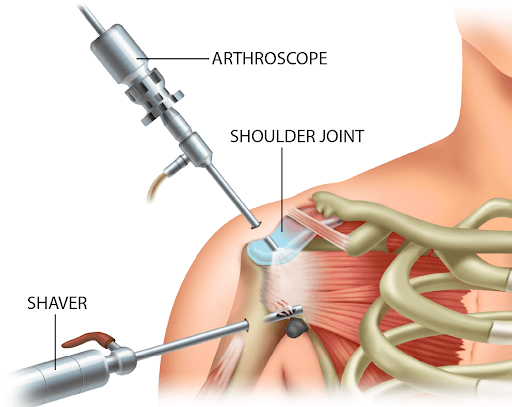
Regenerative Treatment for a Torn Shoulder Labrum
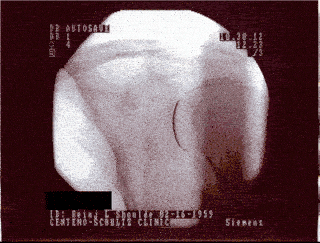
Rather than undergoing the risks associated with surgery and the lengthy rehabilitation process, why not consider regenerative treatment options?
The physicians at the Centeno-Schultz Clinic are experts in the evaluation and treatment of shoulder labrum injuries. PRP and bone marrow-derived stem cells are both potential treatment options that can be injected into the areas of injury. We have pioneered an X-ray-guided technique to safely inject the shoulder labrum. It is a simple outpatient procedure.
Once a small needle is appropriately placed, we inject a very small amount of contrast (dye) to confirm accurate placement. The X-ray pictures below illustrate the labrum being outlined with contrast.
PRP Injections
PRP is short for platelet-rich plasma, and it is autologous blood with concentrations of platelets above baseline values. The potential benefit of platelet-rich plasma has received considerable interest due to the appeal of a simple, safe, and minimally invasive method of applying growth factors. PRP treatments are a form of regenerative medicine that utilizes the blood healing factors to help the body repair itself by means of injecting PRP into the damaged tissue. In regenerative orthopedics, it is typically used for the treatment of muscle strains, tears, ligament and tendon tears, minor arthritis, and joint instability. There have been more than 30 randomized controlled trials of PRP…
Read More About PRP InjectionsChoose Centeno-Schultz Clinic for Your Torn Shoulder Labrum
In conclusion, the shoulder labrum is a crucial structure that enhances the stability and functionality of the shoulder joint. By deepening the glenoid cavity, it secures the head of the humerus, thus providing joint stability and shock absorption, and facilitating a wide range of motion.
It also serves as an attachment point for ligaments and tendons, contributing to the overall strength and coordination of shoulder movements. Understanding the functions and the importance of the labrum is essential in recognizing the impact of labral tears, which can lead to pain, instability, and reduced shoulder performance.
Shoulder labral tears can be caused by repetitive overhead movements, dislocations, degenerative changes, and acute trauma such as a fall on an outstretched arm or a direct blow to the shoulder. Shoulder ligament instability is a common, undiagnosed cause of shoulder labrum tears, which can be easily treated with PRP or bone marrow-derived injections.
Regenerative treatment options offered by the Centeno-Schultz Clinic, such as platelet-rich plasma (PRP) and bone marrow-derived stem cell injections, are alternatives to surgery for shoulder labral tears. These minimally invasive procedures focus on promoting natural healing and tissue regeneration, thereby reducing the risks and recovery time associated with surgical interventions.
By utilizing advanced imaging techniques to ensure precise delivery of regenerative agents, these treatments aim to restore the labrum’s integrity and function effectively. This approach not only minimizes the potential complications linked with surgery but also fosters a quicker return to daily activities and sports.
Are you a Candidate?

Christopher J. Centeno, MD
Christopher J. Centeno, M.D. is an international expert and specialist in Interventional Orthopedics and the clinical use of bone marrow concentrate in orthopedics.
Dr. Centeno is one of the few physicians in the world with extensive experience in the culture expansion of and clinical use of adult bone marrow concentrate to treat orthopedic injuries. His clinic incorporates a variety of revolutionary pain management techniques to bring its broad patient base relief and results. Dr. Centeno treats patients from all over the US who travel to Colorado to undergo innovative, non-surgical treatments. Dr. Centeno has chaired multiple international research-based conferences. He also maintains an active research-based practice, with multiple publications listed in the US National Library of Medicine. Dr. Centeno has also served as editor-in-chief of a medical research journal dedicated to traumatic injury.
Dr. Centeno trained at the Baylor College of Medicine, Texas Medical Center, and the Institute for Rehabilitation Research. He hails from both Florida and New York and currently resides in Boulder, Colorado with his wife and three children.

John Schultz, MD
John R. Schultz M.D. is a national expert and specialist in Interventional Orthopedics and the clinical use of bone marrow concentrate for orthopedic injuries. He is board certified in Anesthesiology and Pain Medicine and underwent fellowship training in both. Dr. Schultz has extensive experience with same day as well as culture expanded bone marrow concentrate and sees patients at the CSC Broomfield, Colorado Clinic, as well the Regenexx Clinic in Grand Cayman. Dr. Schultz emphasis is on the evaluation and treatment of thoracic and cervical disc, facet, nerve, and ligament injuries including the non-surgical treatment of Craniocervical instability (CCI). Dr. Schultz trained at George Washington School of…
Read more
John Pitts, M.D.
Dr. Pitts is originally from Chicago, IL but is a medical graduate of Vanderbilt School of Medicine in Nashville, TN. After Vanderbilt, he completed a residency in Physical Medicine and Rehabilitation (PM&R) at Emory University in Atlanta, GA. The focus of PM&R is the restoration of function and quality of life. In residency, he gained much experience in musculoskeletal medicine, rehabilitation, spine, and sports medicine along with some regenerative medicine. He also gained significant experience in fluoroscopically guided spinal procedures and peripheral injections. However, Dr. Pitts wanted to broaden his skills and treatment options beyond the current typical standards of care.
Read more
Jason Markle, D.O.
Post-residency, Dr. Markle was selected to the Interventional Orthopedic Fellowship program at the Centeno-Schultz Clinic. During his fellowship, he gained significant experience in the new field of Interventional Orthopedics and regenerative medicine, honing his skills in advanced injection techniques into the spine and joints treating patients with autologous, bone marrow concentrate and platelet solutions. Dr. Markle then accepted a full-time attending physician position at the Centeno-Schultz Clinic, where he both treats patients and trains Interventional Orthopedics fellows. Dr. Markle is an active member of the Interventional Orthopedic Foundation and serves as a course instructor, where he trains physicians from around the world.
Read more
Brandon T. Money, D.O., M.S.
Dr. Money is an Indiana native who now proudly calls Colorado home. He attended medical school at Kansas City University and then returned to Indiana to complete a Physical Medicine and Rehabilitation residency program at Indiana University, where he was trained on non-surgical methods to improve health and function as well as rehabilitative care following trauma, stroke, spinal cord injury, brain injury, etc. Dr. Money has been following the ideology behind Centeno-Schultz Clinic and Regenexx since he was in medical school, as he believed there had to be a better way to care for patients than the status quo. The human body has incredible healing capabilities…
Read moreOther Resources for Shoulder Labrum Tears
-
10 Best Shoulder Physical Therapy Exercises to Ease the Pain
Physical therapists often recommend specific exercises to alleviate shoulder pain, recognizing their effectiveness in both treating and preventing shoulder issues. These exercises, designed to enhance strength, flexibility, and mobility, can be a key component of a pain management strategy. Moreover, the ability to perform these exercises at home makes them a convenient option for patients…
-
How To Release A Pinched Nerve In The Shoulder
A pinched nerve in the shoulder occurs when a nerve is compressed or irritated anywhere along its path, from the nerve root where it emerges from the cervical spine to the area in the shoulder it supplies. This can lead to shoulder pain, numbness, and pins and needles, and can even affect the movement of…
-
Treatment For A Torn Rotator Cuff Without Surgery: Exploring Your Options
Welcome to the Guide for Rotator Cuff Tear Relief Without Surgery. Rotator cuff injuries affect millions of people globally (1). The incidence vastly increases with age. Irrespective of the cause, there are many treatment options for rotator cuff injuries apart from surgery. If you want to avoid rotator cuff surgery, you’re in the right place!…
-
When Not to have Rotator Cuff Surgery? Know Your Options
It happened as you were playing racketball. There was loud pop followed by immediate pain. Moving your shoulder is almost impossible. What is the rotator cuff? What causes rotator cuff tears? What is rotator cuff surgery? When not to have rotator cuff surgery? Let’s dig in.What Is the Rotator Cuff? (4 Tendons) The rotator cuff…
-
KT Tape Shoulder: Facts You Need to Know!
KT Tape is used extensively for shoulder injuries. Dr. Schultz discusses what KT tape is, what it is used for, how it helps shoulder pain, whether it really works and a better solution.
-
Rotater Cuff Tear Surgery
Shoulder Pain Shoulder pain can come in many different forms and be caused by many different issues. Many structures exist in a small area making it more difficult to accurately diagnose what is causing pain without spending appropriate time to diagnose the issue. Common causes of shoulder pain include shoulder arthritis, acromioclavicular (AC) joint sprain…
Footnotes
- Van Blarcum GS, Svoboda SJ. Glenohumeral Instability Related to Special Conditions: SLAP Tears, Pan-labral Tears, and Multidirectional Instability. Sports Med Arthrosc Rev. 2017 Sep;25(3):e12-e17. doi:10.1097/JSA.0000000000000153.
- Schrøder CP, Skare Ø, Reikerås O, Mowinckel P, Brox JI. Sham surgery versus labral repair or biceps tenodesis for type II SLAP lesions of the shoulder: a three-armed randomised clinical trial. Br J Sports Med. 2017 Dec;51(24):1759-1766. doi: 10.1136/bjsports-2016-097098. Epub 2017 May 11. PMID: 28495804; PMCID: PMC5754846.
- Huang H, Zheng X, Li P, Shen H. Arthroscopic reconstruction of shoulder’s labrum with extensive tears. Int J Surg. 2013;11(9):876-81. doi: 10.1016/j.ijsu.2013.07.015. Epub 2013 Aug 2. PMID: 23917210.
- Wall A, McGonigle O, Gill TJ. Arthroscopic Circumferential Labral Repair for Patients With Multidirectional Instability: A Comparative Outcome Study. Orthop J Sports Med. 2019 Dec 27;7(12):2325967119890103. doi: 10.1177/2325967119890103. PMID: 31909054; PMCID: PMC6935876.